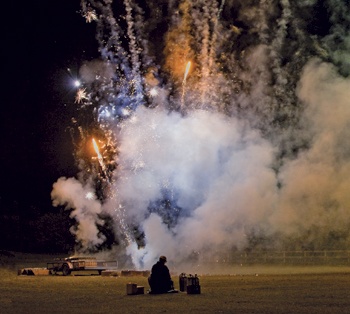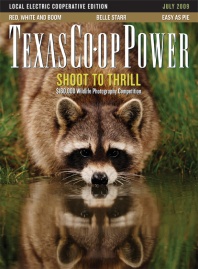The aerial fireworks that Randy Beckham tests on his North Texas ranch are so bright in the dark country sky, they sometimes get mistaken for scheduled displays in nearby towns.
“We shoot some pretty big stuff out here,” says Beckham, whose fireworks company, Pyrotex, will be busy this Fourth of July firing shows in 34 cities, small towns and country clubs around the state. “One Friday night in the fall we tested some product, and I had people thanking me for the halftime show at the Leonard football game. They said it helped the team.”
Independence Day is the most hectic time of the year for Beckham’s crews, who travel as far as Brady (southeast of San Angelo) and Washington (south of College Station) to launch their colorfully explosive displays. But with fireworks becoming more common at weddings, Christmas tree lightings, New Year’s Eve celebrations, high school and college homecomings, and corporate events, Pyrotex’s three full-time employees and 49 part-timers have their fingers on the firing button year-round.
Every display is designed and at least partly assembled at Pyrotex’s 80-acre ranch headquarters in southwest Fannin County, a normally peaceful setting of pastures and oak groves where one can get a behind-the-scenes look at the anatomy of a modern fireworks show. Each July, Beckham places his order to suppliers in China for the aerial shells he will use during the coming year. With the shells as large as
8 inches in diameter, the fireworks are stored in 10 metal bunkers spaced a safe distance apart. In a nearby assembly building, shells are connected with a time-delay fuse that is fired electrically at show time; the shells fire in an order carefully synchronized to a musical score Beckham has arranged.
Safety comes first during the assembly process. “The walls are made out of Styrofoam, so you can run right through them if you need to,” the 52-year-old Beckham says of the assembly building, explaining how employees could escape in the case of an explosion or fire.
As another precaution, there is no electrical lighting inside the building. During the day, it is illuminated by natural light streaming through special, south-facing clerestory windows that are built high on the wall. At night, lights mounted on the outside of the building shine through the windows.
Stacks of pallets holding the plastic mortar tubes used for firing the shells sit in a barn near the ranch entrance. So many mortars are used in a good-sized show that it takes a 48-foot trailer to haul them to the site. Beckham’s largest show ever consisted of 140,000 shells and other effects, or fireworks, fired over a 101/2-minute period for a society wedding in Houston.
For his Independence Day regulars—from Wolfe City, a small town near his ranch, to Southlake, a well-to-do Dallas-Fort Worth suburb whose business district resembles an old-time town square—he sets off between 4,000 to 100,000 effects.
With crews and trailers departing and arriving over a run of a few days, the first week in July is an exercise in logistics, one Beckham has perfected over his 30 years in the business.
Fresh out of Southern Methodist University, where he studied theater and film, Beckham went to work for a company that staged multimedia presentations at company events. “This is back in the day when multimedia meant 20 slide projectors stacked up in a row,” he recalled. One client, a manufacturer of flea collars and roach motels, wanted more pizzazz for a sales presentation. So Beckham brought in an indoor pyrotechnic display like those catching on with rock bands and magic shows. He soon struck out on his own as a distributor of “indoor pyro,” supplying musical touring acts such as Nazareth, the Bee Gees, the Commodores and Reba McEntire. Later, he began producing indoor fireworks and by the late 1980s had added outdoor aerial displays as well.
A number of technological advances during Beckham’s time in the business have made for more artistic and complex displays and safer working conditions. “When we first got into the industry we were hand-lighting all the fireworks. You had a 3-foot-long road flare in your hand, you lit a fuse and ducked,” he remembered. Electric firing devices came along, allowing technicians to be up to 100 feet away. They, in turn, are being replaced today by computerized systems extending the safety margin to 150 or 200 feet, he said.
The size, complexity and color range of the air bursts advance a little every year, although some of it can get lost on breezy summer evenings in Texas. “In the last 10 years or so, they’ve become a lot more elaborate. You can shoot the letters USA as a group, but when the winds blow it tears them apart,” Beckham said. “We shot a shell that formed the shape of the state of Texas over the Palo Duro Canyon, but when it got above the cliff tops the wind caught it and it could have been Oklahoma or Tennessee. It looked like Texas for three or four seconds, at most.”
The wider selection of colors has been a plus for the wedding business, where shows are highly customized in pastel hues. But sometimes, Beckham has to convince demanding brides that a display in nothing but pink might not be the best way to go.
For the most part, though, fireworks mean the Fourth of July, with a soundtrack mixing, say “God Bless America” sung by country performer LeAnn Rimes with “America the Beautiful” sung by soul man Ray Charles. Beckham gets ready for the holiday by hosting “pyro camp,” his annual training weekend at the ranch when new and old employees fire test shows and try out new products.
Among his regular hands is Darnetta Miles, a lead pyrotechnician and manager of the anatomic pathology lab at Dallas’ Parkland Hospital. She met Beckham through a friend who knew she’d be right for a holiday fireworks crew. “I’ve always loved watching fireworks,” says Miles, who has a “life list” of watching fireworks displays the same way some people have one for riding roller coasters. “My daughter and I have been to shows in London, California, New York. When they reopened the Statue of Liberty in 1986 (after it was refurbished), I was there. It was one of the largest I’ve ever been to.”
To Miles, the Fourth of July means spending hours setting up mortars and fuses in the summer heat—at times in dry, mowed fields teeming with chiggers. Come nightfall, though, all that work pays off in thrills. “When you’re firing it, it’s really all around you, it’s beautiful and it’s loud,” she said. “I truly have the best seat in the house.”
——————–
Thomas Korosec wrote about the Fort Worth Stock Show and Rodeo for Texas Co-op Power in January 2009.


